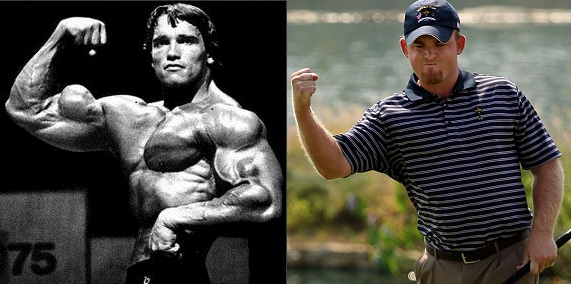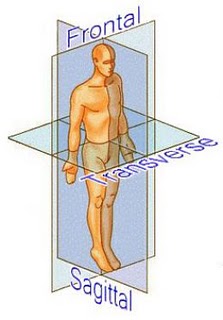The SECRET to Crushing a Huge Drive on the Golf Course
Let’s face it guys, chicks dig the long ball. The funny thing is that there seems to be little correlation between being big and strong and hitting the long ball. I have seen many a mighty man swing as hard as he can only to duff the ball just past the ladies’ tee or hit a duck hook that ends up 2 fairways over. The proof that you don’t need to be a big & strong guy to crush your tee shot can be seen in the stats of the top 5 drivers on the PGA tour (list includes a couple other big names):
| Driving Distance Leaders on the PGA Tour (in yards) | ||||
| Rank | Name | Height | Weight | Average(yds) |
| 1 | J.B. Holmes | 5 ft 11 in | 190 lbs | 311.7 |
| 2 | Bubba Watson | 6 ft 3 in | 180 lbs | 310.7 |
| 3 | Dustin Johnson | 6 ft 4 in | 190 lbs | 310.0 |
| 4 | Chris Baryla | 6 ft 0 in | 180 lbs | 309.0 |
| 5 | Angel Cabrera | 6 ft 0 in | 210 lbs | 303.1 |
| 14 | Phil Mickelson | 6 ft 3 in | 200 lbs | 296.9 |
| 67 | Tiger Woods | 6 ft 1 in | 185 lbs | 289.6 |
| Note: Y-T-D statistics through Shell Houston Open Apr 03, 2011 Source: http://www.pgatour.com |
||||
Looking at the top 5: Average Height = 6 ft 1 in, Average Weight = 190 lbs, Average Drive = 308.9 yds. I think that it is safe to say that none of the above have ever been mistaken for Arnold Schwarzenegger, Lou Ferrigno or Mr. Olympia AND I doubt anyone has ever asked any of them how much they can bench, squat or deadlift. The point I am making here is that these are not the biggest and strongest guys so, you wouldn’t suspect that they can crush a 300 yard drive. So, what’s their secret?
Whereas most other sports require you to move back and forth or side to side, golf requires that you twist. Hence, most sports operate in the Sagittal plane (forwards & backwards) and Frontal plane (up, down and side to side), but Golf operates in the Transverse plane (rotational)
While Core Strength and Flexibility are important for golf, Strength and Flexibility in the Transverse Plane is the SECRET to hitting the long ball!!! The only problem is, most sports and most lifts are of the push / pull variety. The “core barbell lifts” (bench, squat and deadlift) don’t lend themselves to any rotation whatsoever. What other sports are similar in movement to golf? Football? Nope…Baseball? Kinda, but not really…Basketball? Nope…I GOT IT!!! THROWING EVENTS IN TRACK AND FIELD!!! The Hammer, Discus and Shotput all involve movement in the Transverse plane and require more strength and explosive power than golf. While it is a very niche area of training, I am fortunate to be friends with a Strength Coach who is an expert on training for the throwing events, Matt Ellis of Primal Athlete Training Center in Cranston, Rhode Island. Matt was a thrower in High School and College and his primary focus at Primal ATC is training throwers. Matt and I are HTKA Brothers and he is a guy who eats, sleeps and breathes the throwing events.
I reached out to Matt to pick his brain on training in the transverse plane and instead of just answering my questions over the phone or via e-mail, Matt was cool enough to put together a great video which includes advice and exercises for Building Strength and Flexibility in the Transverse Plane. Golfers and Throwers are both trying to produce power and torque through the transverse plane. To crush a long drive or be a good thrower, you need to produce a lot of rotational torque through the body and the hips. The goal for a thrower or a golfer is to keep their feet stationary and turn their hips and shoulders as far as possible to generate the most torque. So, while it is important to be strong in the hips, core, lower back and glutes, you MUST be flexible as well. It is not just about the mid-section being strong; it also has to be super flexible to generate a massive amount of rotational torque and power.
Watch Matt Ellis show us 3 exercises to improve strength and flexibility in the transverse plane:
1) Seesaw press with Kettlebells
Grab two kettlebells (one in each hand) in the rack position. Since our goal is to move a small implement as quickly as possible (golf club, shotput, etc.), we are focusing on using lighter weights so we can generate explosive power. With your feet a little more narrow than shoulder width, rotate your upper body while pressing one kettlebell overhead and keeping the kettlebell on the non-rotating side in the rack position. Finish looking behind yourself with the line of your shoulders at a 90 degree angle to the line of your feet. Rotate back to facing forward while bringing the kettlebell back to the rack position and do the same movement going the other way. Perform exercise as one fluid motion rotating left and right.
2) Side Snatch with a Kettlebell
Get into position to perform a kettlebell snatch with the kettlebell between your feet, back flat and knees bent. Start out with the Kettlebell on the inside of one leg (e.g. INSIDE LEFT FOOT), grab it with the hand of the opposite side (e.g. RIGHT HAND), load the hips and drive your feet into the floor using your legs and upper body to explosively lift the Kettlebell overhead to the opposite side (e.g. RIGHT SIDE ABOVE SHOULDER) with arm at full extension. For example, the Kettlebell would be on the inside of your left foot, you would reach across and down, grab it with your right hand and perform a snatch to the right side.
3) Russian Twists with a Thick Rope through a Kettlebell
Matt learned this exercise from World Class Hammer Thrower Koji Murofushi of Japan. Loop a thick rope (2-3 inch diameter) through a Kettlebell, put feet and hips on a flat bench, with elbows tucked in tight to the body, use core and upper body to lift the thick rope and Kettlebell up off the ground and over your body to the other side and bring it down without having it touch the floor. Continue motion side to side in a rhythmic fashion. This exercise forces our feet to stay on the bench and it is forcing our upper body to twist. As long as we keep the elbows by the ribs, we can turn properly and increase flexibility through the hips and the mid-section while increasing strength. We are not working on moving a heavy weight slowly; we are working on moving a medium-sized weight as fast as possible. This increases the strength in our core AND our flexibility. This will carry over to the golf course and the shotput circle.
To learn more about Matt Ellis and his unique methods for training Discus, Shotput and Hammer Throwers, visit Primal Athlete Training Center here: http://www.primalatc.com/
Did you enjoy this post? Buy me a cup of coffee ![]()







matt,
nice exercises !! thanks for the tips….
Matt,
Thanks for the video. 2 things. 1. If you personally shoot 90, you are only taking around 45 to 50 full swings. I’ll bet you take most of you strokes on the green, which is pretty low intensity. 2. With your workout conditioning, how far did you hit your average drive before and how far do you hit it after your training protocol took effect. TY.
S.
You are correct, chip shots and putts do not require torque or max intensity, those are “touch” shots based on feel. On the other hand, irons and woods require torque and strength for maximum distance. The training added 20-25 yards to my drive.